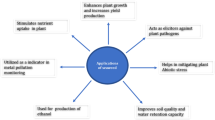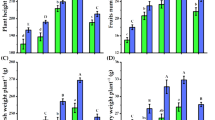Abstract
We analyzed phenolic compounds and other elements in leaf extracts and compared morphology of three species of the Phytolaccaceae family found in South Korea. To test allelochemical effects of the three Phytolacca species, we also examined seed germination and dry weight of seedlings of Lactuca indica and Sonchus oleraceus treated with leaf extracts. The concentrations of total phenolic compounds were exotic Phytolacca esculenta (3.9 mg/l), native Phytolacca insularis (4.4 mg/l), and exotic Phytolacca americana (10.2 mg/l). There was no significant difference in concentrations between P. esculenta and P. insularis, but the concentration of total phenolics in P. americana was two times higher than either P. esculenta or P. insularis. Analysis of aqueous extracts by HPLC showed seven phenolic compounds (gallic acid, protocatechuic acid, chlorogenic acid, caffeic acid, m-hydroxybenzoic acid, ρ-coumaric acid, and cinnamic acid). Total phenolics in P. americana were eight to 16 times higher than either P. esculenta or P. insularis, respectively. P. americana inhibited seed germination and dry weight of the two assay species. The phytotoxic effects of the two Phytolacca species were different, despite the fact that P. esculenta and P. insularis had similar levels of total phenolic compounds. We also found that P. americana had invaded Ullung Island, which suggested that P. americana had excellent adaptability to the environment. The three species of Phytolaccaceae in South Korea can be distinguished by their different allelopathic potentials and morphologies.




Similar content being viewed by others
References
Agricultural Improving Institute. 1988. Methods of Soil Chemical Analysis, p. 450.
H. M. Appel (1993) ArticleTitlePhenolics in ecological interactions: The importance of oxidation J. Chem. Ecol. 19 1521–1552
H. P. Bais R. Vepachedu S. Gilroy (2003) ArticleTitleAllelopathy and exotic plant invasion: From molecules and genes to species interactions Science 301 1377–1380
A. J. M. Baker R. R. Brooks (1989) ArticleTitleTerrestrial higher plants which hyperaccumulate metallic elements. A review of their distribution, ecology and phytochemistry Biorecovery 1 81–126
P. C. Bhowmik J. D. Doll (1984) ArticleTitleAllelopathic effects of annual weed residues growth and nutrient uptake of corn and soybeans J. Agron. 76 383–388
R. M. Callaway E. T. Aschehoug (2000) ArticleTitleInvasive plants versus their new and old neighbors: A mechanism for exotic invasion Science 290 521–523
B. R. Dalton (1989) ArticleTitlePhysiochemical and biological processes affected the recovery of exogenously applied ferulic acid from tropical forest soils Plant Soil 115 13–22
R. Moral ParticleDel (1972) ArticleTitleOn the variability of chlorogenic acid concentration Oecologia 9 289–300
F. A. Einhellig (1995) Mechanism of action of allelochemicals in allelopathy Inderjit (Eds) Allelopathy: Organisms, Processes, and Applications. ACS Symp Ser 582 Am. Chem. Soc. Washington, DC 96–116
S. M. Han K. H. Bae K. S. Choi (1998) ArticleTitleIdentification and bioassay of bioactive compounds isolated from Phytolacca americana Kor. J. Ecol. 21 35–45
R. M. Heisey (1990) ArticleTitleAllelopathic and herbicidal effects of extracts from tree of heaven (Ailanthus altissima) Am. J. Bot. 77 662–670
Inderjit. 2003. Ecophysiological aspects of allelopathy. Planta 217:529–539.
Inderjit K. M. M. Dakshini (1998) ArticleTitleAllelopathic interference of chickweed, Stellaria media with seedling growth of wheat (Triticum aestivum) Can. J. Bot. 76 1317–1321
R. M. Keane M. J. Crawley (2002) ArticleTitleExotic plant invasions and the enemy release hypothesis Trends Ecol. Evol. 17 164–170
T. A. Kennedy S. Naeem K. M. Howe (2002) ArticleTitleBiodiversity as a barrier to ecological invasion Nature 417 636–638
Y. O. Kim E. J. Lee H. J. Lee (2000) ArticleTitleAntimicrobial activities of extracts from several native and exotic plants in Korea Kor. J. Ecol. 23 353–357
Lavid, N., Schwartz, A., Yarden, O., and Tel-Or, E. (eds.). 2001. The involvement of polyphenols and peroxidase activities in heavy-metal accumulation by epidermal glands of the water lily (Nymphaeaceae). Planta 212:323–331.
T. B. Lee (1985) Illustrated Flora of Korea Hyangmunsa Seoul 990
H. J. Lee Y. O. Kim N. K. Chang (1997) ArticleTitleAllelopathic effects on seed germination and fungus growth from the secreting substances of some plants Kor. J. Ecol. 20 181–189
M. A. K. Lodhi (1976) ArticleTitleRole of allelopathy as expressed by dominating trees in a lowland forest in controlling the productivity and pattern of herbaceous growth Am. J. Bot. 63 1–8
J. Lydon J. R. Teasdale P. R. Chen (1997) ArticleTitleAllelopathic activity of annual wormwood (Artemisia annua) and the role of artemisinin Weed Sci. 45 807–811
A. C. Neish (1964) Major pathways of biosynthesis of phenols J. B. Harborne (Eds) Biochemisty of Phenolic Compounds Academic Press New York 295–359
S. H. Park (1995) ArticleTitleUnrecorded naturalized species in Korea Kor. J. Species Tax. 25 123–130
S. H. Park (1995) Colored Illustrations of Naturalized Plants of Korea Ilchokak Seoul 376
Y. M. Park B. J. Park K. R. Choi (1999) ArticleTitlepH changes in the Rhizosphere soil of Phytolacca americana Kor. J. Ecol. 22 7–11
F. Pellissier (1993) ArticleTitleAllelopathic inhibition of spruce germination Acta Ecol. 14 211–218
Phillips, L. E., Choi, H. G., Saunders, G. W., and Kraft, G. T. (eds.). 2000. The morphology, taxonomy, and molecular phylogeny of Heterocladia and Trigenea, with delineation of the little-known tribe Heterocladieae. J. Phycol. 36:199–219
I. Raskin R. D. Smith D. E. Salt (1997) ArticleTitlePhytoremediation of metals: Using plants to remove pollutants from the environment Curr. Opin. Biotechnol. 8 221–226
E. L. Rice (1984) Allelopathy EditionNumber2 Academic Press New York
E. L. Rice (1995) Biological Control of Weeds and Plant Diseases: Advances in Applied Allelopathy University of Oklahoma Press Norman, OK
Y. Sakihama H. Yamasaki (2002) ArticleTitleLipid peroxidation induced by phenolics in conjunction with aluminum ions Biol. Plant 45 249–254
L. J. Santiago M. Louro D. E. Oliveira ParticleDE (2000) ArticleTitleCompartmentation of phenolic compounds and phenylalanine ammonia-lyase in leaves of (Phyllanthus tenellus Roxb.) and their induction by copper sulphate Ann. Bot. 86 1023–1032
InstitutionalAuthorNameSAS Institute (2000) SAS/STAT Guide for Personal Computers, Version 6.03 ed. SAS Inst., Inc. Cary, NC, USA
T. Swain W. E. Hillis (1959) ArticleTitleThe phenolic constituents of Prunus domestica I. The quantitative analysis of the phenolic constituents J. Sci. Food Agric. 10 63–68
Veronneau, H., Greer, A. F., Daigle, S., and Vincent, G. (eds.). 1997. Use of mixtures of allelochemicals to compare bioassays using red maple, pin cherry, and American elm. J. Chem. Ecol. 23:1101–1117
M. Vila J. Weiner (2004) ArticleTitleAre invasive plant species better competitors than native plant species?: Evidence from pair-wise experiments. Oikos 105 229–238
L. Wu X. Guo M. A. Harivandi (1998) ArticleTitleAllelopathic effects of phenolic acids detected in buffalograss Buchloe dactyloides clippings on growth of annual bluegrass Poa annua and buffalograss seedlings Environ. Exp. Bot. 39 159–167
A. M. Zobel P. A. Clarke J. M. Lynch (1999) Production of phenolics in response to UV irradiation and heavy metals in seedlings of Acer species F. A. Macias J. C. G. Galindo (Eds) Recent Advances in Allelopathy, Vol. 1 Servicio De Publicaciones Universidad De Cadiz Spain 231–242
Acknowledgments
Y. O. Kim and E. J. Lee were supported by Brain Korea 21 program in South Korea.
Author information
Authors and Affiliations
Corresponding author
Rights and permissions
About this article
Cite this article
Kim, Y.O., Johnson, J.D. & Lee, E.J. Phytotoxic Effects and Chemical Analysis Of Leaf Extracts from Three Phytolaccaceae Species in South Korea. J Chem Ecol 31, 1175–1186 (2005). https://doi.org/10.1007/s10886-005-4255-z
Received:
Accepted:
Published:
Issue Date:
DOI: https://doi.org/10.1007/s10886-005-4255-z




